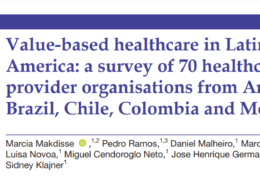Value-based care, implemented using lean principles and in conjunction with an ongoing, community-wide effort to address social determinants of health, can reduce health spending and deliver on the promise of better health, for children and for all (Nemour´s Children)
HBR — Harvard Business Review
by David J. Bailey
June 16, 2017
Summary.
- Nemours Children’s Health System has found that while a value-based care approach can decrease the costs of care for children with chronic conditions (when compared with a traditional fee-for-service model), transitioning to a value-based model involves added infrastructure and training costs.
- There’s also the complexity of delivering care in an industry that mixes together fee-for-service and value-based reimbursement.
- To deliver on the promise of improved health and reduced spending, value-based care must be augmented with a structured approach to eliminating waste, such as Lean innovation methods.
- Moreover, value-based care is most effective when delivered in conjunction with efforts to mitigate broader issues that create problems for patients, such as lack of transportation, inadequate housing, and inability to read prescriptions.
Despite spending twice what other developed nations spend on a per capita basis for health care, the United States has a longstanding trend of having lower life expectancy, greater prevalence of chronic disease, and overall poorer health outcomes.
One proposed solution for this is to change the payment model of our health care system from the predominant fee-for-service (FFS) model, which reimburses services regardless of outcome, to a value-based model in which outcomes are reimbursed.
Our experience at the Nemours Children’s Health System suggests that value-based care (VBC) is necessary to significantly improve health outcomes and to lower costs for children with chronic illness and complex medical conditions. We have found that a VBC approach can decrease the direct costs of care for a group of children with a chronic condition.
However, transitioning to a VBC approach involves added infrastructure, training costs, and complexity of delivering care in an environment that mixes fee-for-service and value-based reimbursement.
In addition, we believe that in order to deliver on the promise of improved health and reduced spending, VBC must be augmented with a structured approach to eliminate waste and be delivered in conjunction with a broad-based effort to address factors that are outside of the traditional boundaries of healthcare.
One example illustrates this well. In 2012 Nemours implemented a pilot program to improve asthma outcomes — asthma is the most common chronic disease in childhood — for a population of children in Delaware, where we had an established network of primary care clinics and where, in 2004, we established Nemours Health and Prevention Services, a freestanding population health division dedicated to addressing the social determinants of health in collaboration with the larger community.
A significant body of evidence shows that at least 80% of what affects health outcomes is typically outside of the clinical realm.
It includes
- social factors (employment, family and social support, income, education),
- behaviors (diet and exercise, tobacco, alcohol and drugs, sexual activity), and
- the physical environment (housing, air and water quality, transportation).
Passage of the Affordable Care Act, in 2010, signaled the advent of VBC and an emphasis on population care.
Since most of Nemours’s patient revenue was from fee-for-service contracts, we designed this pilot program to integrate our population health expertise with our clinical operation, in an effort to better understand value-based care and reimbursement models and to further improve health outcomes in a population of children with asthma.
Our pilot effort was supported in part by a federal grant.
The primary care clinics involved became certified patient-centered medical homes, and we expanded the typical physician-nurse team that managed asthma to include a social worker, a psychologist, and a case manager.
Evaluation, diagnosis, and treatment were standardized according to the best evidence and templated in the electronic health record so that the only deviations to clinical care were driven by individual patient factors.
School nurses were given access to the electronic health record with parental permission.
In addition, we hired community health workers to work with families at home and in school to evaluate for triggers of asthma, as well as to educate and support them in dealing with various issues that could affect the child’s asthma care.
These community liaisons linked families to community resources, explored community factors potentially affecting asthma, and advocated at the state and local policy level for system changes, such as the cessation of buses idling around schools, which contributes to poor air quality and can trigger an acute asthma attack.
Other actions outside our usual provision of care included finding housing for some families, providing transportation, lobbying to change the type of pesticides used in public housing, and even encouraging the donation of new mattresses for some children.
The results after three years were remarkable for the children enrolled in the pilot:
- We saw a 60% reduction of asthma-related ER visits,
- a 44% reduction in asthma-related hospital admissions, and more than a $2,100 reduction in annual medical costs per child.
- Their asthma was much more stable, requiring fewer office visits and fewer hospital services.
- The outpatient costs associated with this care model were increased due to the large expansion of the team.
However, this was outweighed by the reduction in utilization of hospital services.
In a FFS model, which still describes the majority of our patient care revenue, this reduced medical cost per child benefits only the payer.
We suffered a financial loss because there was a significant reduction of utilization of hospital services that otherwise would have been reimbursed (the grant mitigated some of that loss.)
The pilot ended after three years, and we have maintained that model of care for children with asthma. However, despite the remarkable improvement of outcomes demonstrated in the pilot, that model of care is simply not sustainable when implemented broadly with FFS reimbursement.
There were also many other barriers to effective care, including lack of transportation, inadequate housing, and inability to read prescriptions. These barriers could not be addressed with FFS.
Even some value-based reimbursement models would not lead to financial sustainability of our piloted care model, due to their complexity and the significant investment required at the home, community, and policy levels.
A number of reimbursement methods fall under the general phrase “value-based reimbursement.”
These include pay-for-performance, shared savings, bundled payments, alternative payment methods associated with accountable care organizations and patient-centered medical homes, and full risk-bearing for providers as seen in capitation.
Most health systems will need to manage a multitude of reimbursement methodologies. The increasing complexity of having to track performance for many different payment systems and meet different reporting requirements of quality and safety outcomes will likely increase administrative costs.
As the movement to VBC has proceeded at an uncertain tempo, with the possibility of operating in a mixed reimbursement environment for quite some time, Nemours has pursued an additional avenue to transform care and enhance value that is compatible with any model of care or reimbursement.
For the past five years, we’ve committed to the philosophy and tools of the lean methodology, a structured approach to creating more value with fewer resources.
- Lean’s core principles include value being defined by the customer’s (patient’s) needs, aggressively removing waste from processes, improving processes continually, and engaging employees actually doing the work to identify issues and provide solutions.
- This approach is helping us improve outcomes and reduce cost, which creates a foundation for success regardless of the reimbursement model.
Using lean, we have decreased hospital length of stay and readmissions across our network, increased unit capacity without expansion, and reduced spending for capital projects.
One example of a process improvement delivering value directly to patients is the virtual elimination of preadmission testing before the day of surgery — we’re now able to accomplish all of the work on the day of surgery.
This has resulted in fewer cancellations of surgical cases and improved patient satisfaction, with no adverse impact on surgical start times.
The cumulative effect of changes such as this has been improved quality and safety, top-tier patient satisfaction, and millions of dollars in annual cost savings.
These savings partially mitigate the high costs associated with transitioning to a value-based system and are helping fund our ongoing population health efforts (which we believe are necessary to make VBC work) that remain independent of the reimbursement model.
These savings partially mitigate the high costs associated with transitioning to a value-based system and are helping fund our ongoing population health efforts …
The changes necessary to transform the health of any population are simple:
- Embed healthful behaviors from birth,
- reward care efforts for outcomes rather than volume, and
- provide patients with the ability and tools to truly engage in their own health.
But implementation is exceedingly complex.
We believe that value-based care, implemented using lean principles and in conjunction with an ongoing, community-wide effort to address social determinants of health, can reduce health spending and deliver on the promise of better health, for children and for all.
Originally published at https://hbr.org on June 16, 2017.












